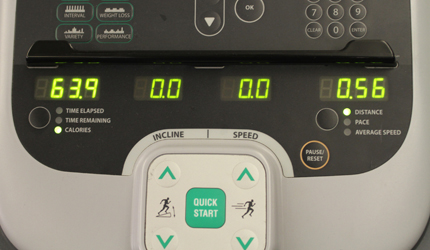
According to fitness professionals, the calorie calculator on popular cardiovascular machines is based off of a general height and weight assumption that may not apply to all exercisers.
By Molly Dunn
Reporter
As convenient as it is to have a treadmill or elliptical reveal the amount of calories burned during an exercise, these machines are not as accurate as believed. Many cardiovascular machines are 15 to 20 percent off in calculation of calories burned, Van Davis, assistant director for fitness and nutrition education.
Davis said cardio machines do not display an accurate calorie count because the calculation is based off a general standard.
“It’s based on a general weight of a person and so it’s not going to tell you the accurate calorie count because how much you expend is going to be based upon whether you are a beginner level or advanced level, or if you have more muscle mass or not,” Davis said.
Heather Wood, a Livestrong.com freelance writer, wrote in an article on the site that body composition is a necessary component in determining a more accurate amount of calories burned.
“People with more lean muscle mass will have a higher metabolic rate than those with more body fat,” Wood said. “If you weigh 140 pounds and have 25 percent body fat, you can expect your calorie burn rate to be higher than a person who weights 140 pounds and has 35 percent body fat.”
Two people weighing the same amount will burn a different number of calories, even if they do the same exercise.
According to a cardio machine, however, they will burn the same number of calories.
“When a person is 130 pounds and gets on a treadmill at level five for 30 minutes, it’s going to give you the same calorie expenditure as another person getting on at 130 pounds at the same amount of time whether or not that person is a beginner or advanced,” Davis said.
Clint Patterson, fitness coordinator at the McLane Student Life Center, said more factors are involved in determining accurate calorie expenditure.
“Sometimes the technology of the machine may not be up to speed,” Patterson said. “They are accurate in a sense that they probably provide a very good estimation, but that’s not something that you should direct your exercise towards, as far as the numbers.”
In order for a more accurate calorie count, Davis and Patterson both said personal data entries of height, weight, body mass and age are necessary, but the heart rate is uniquely important.
“Some heart rate monitors, you can personalize them,” Patterson said. “The machines in the weight room are shared by a lot of people. You’re not the only one using it. Nobody else is going to wear your own heart rate monitor.”
Davis said target heart rates vary based on fitness level.
“If they’re beginners they want to be working at 60 or 70 percent of their maximum heart rate,” Davis said. “If they’re more advanced, they could be working at a higher heart rate.”
Davis said those working out can consider the number of calories burned according to a cardio machine to be a fair estimate of actual number of calories burned, but said students should work towards achieving a healthy lifestyle rather than just burning calories.
“The goal of exercise is just to enjoy and pursue a healthy lifestyle and not be as wrapped up or as directed at a particular number,” Patterson said.
“You may lose your focus from what your goals are whenever you begin,” Paterson said.



